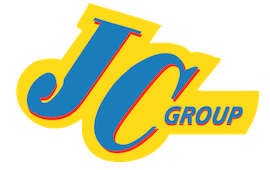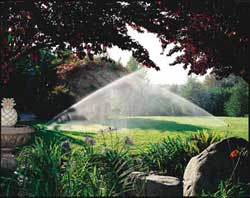|

______________________





Service Packages Contracts
__________________
Please also visit our
LANDSCAPE
LIGHTING
DIVISION
_________________
|
The Benefits of Owning an
Automatic Sprinkler System
Many people say convenience is the biggest advantage to an automatic
system since they don't have to spend their time watering by hand or
moving the hose around the yard.
Others say extended plant life and lower water usage are
the most important benefits.
Still others believe a sprinkler system is one of the best financial
investments they have made in their home since appearance is a key factor
in determining market value.
And guess what - they're all right!

Irrigation installation requires more than laying
piping and securing spray heads. Professional landscapers will know
how to avoid gas lines when laying your new pipes.
They will also be aware of any restrictions in using city or well
water, and be informed of your special local codes. For example, a
professional plumber may be required to hook the irrigation system
to the main water lines, and an electrician may also be required to
review any electrical work done in connection with the project, such
as automatic timers.
Even the most ambitious do-it-yourself gardeners should think twice
before tackling the installation of a new irrigation system without
the advice of a professional irrigation contractor. Measuring the property,
calculating its slope, and properly adjusting for water pressure are
just some of the tasks involved in home garden irrigation, and to do
it right requires the expertise of professionals. This doesn't mean
that clients are left out of the loop altogether. The professional landscaper
will rely on you as the client to provide details of your gardening
plan (turf vs. shrubs) and your budget. To get the most out of your
relationship with your landscaper, however, a basic understanding of
irrigation systems is quite an advantage.
Four common types of irrigation systems exist:
spray, rotary, flood and micro-irrigation.
|
|
Spray systems
are the most popular form of irrigation for home lawns and gardens,
and are most advantageous for small yard areas. The nozzles are
easily changed to accommodate different spray positions, and the
system in general is quite dependable, requiring little maintenance.
Spray systems are also ideal for weak pressure systems. The spray
can throw a continuous stream of water from zero to fifteen feet.
The only real disadvantage of a spray system is the wind factor,
as high breezes lift the spray away from its target area.
T |
|
Rotary systems
are most frequently used for large areas and are commonly
seen on athletic fields. Rotary systems throw one or more
streams of water up to 100 feet. This system is advantageous to
cover large areas in which a high number of spray heads would be
impractical.
Despite the velocity of the water from the sprayer, rotary
systems actually produce less water than spray systems. The
same-sized area on a rotary system would have to be watered four
times more frequently than with a spray system. Also, rotary
systems are prone to sticking -- watering in one direction
without rotation.
The heads used on rotary systems include gear driven, ball
driven and impact devices. As the name suggests, gear driven
heads use internal gears to rotate the head, while the ball
driven head uses a small ball rotating in the head. Impact
devices have the gear actually strike itself to rotate the head.
|
|
Flood systems
are those that irrigate low to the ground. Bed sprays, bubblers
and jet systems are all types of flood irrigation.
Flood systems work well for plants, such as roses, that have adverse
affects to damp foliage. Bubblers and jets are limited to the
type of soil conditions in which they operate.
Sandy conditions would cause the water to sink on impact rather
than spread throughout the garden. Heavy clay soil, however, would
cause immediate run-off. The reduced water flow from flood systems
is not effective for large lawn areas.
|
|
 |
|
Any system that generates a low
volume of water is classified as a
micro-irrigation system. Typical micro-irrigation
systems include drip, trickle and some spray heads. Micro-irrigation
is ideal for small areas of plants whose foliage cannot be sprayed.
The water supply drips or trickles from plastic tubing close to
the root, never touching the plants' leaves.
This system is high maintenance, however.
Tubing is often covered by mulch or plant foliage and the orifices
can easily become clogged.
Even the most diligent gardeners might not realize a clog in their
micro system until the affected plants begin to show signs of
stress.
If not properly laid, the tubing
can be unsightly and is easy prey for mowers and vandalism. The
tubes are also known to break in freezing weather.
The use of a professional in your irrigation project doesn't
mean that you cannot play an active role in implementing your new
system. The four irrigation systems are only the beginning, and
research on valve types and controller options will go a long way
to ensuring that you receive the irrigation system that works best
for you.
By:
/la.essortment.com
|
|
HOME
| BENEFITS | INSTALLATION/SERVICE
| CONTACT | CAREERS
| SERVICE PACKAGES
|
JC GROUP LIGHTING DIVISION
For More information (416) 651-8555
Copyright © 2024 JC Group. All rights reserved.
|
|


